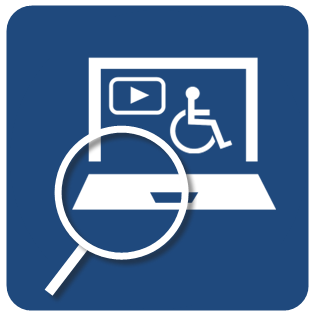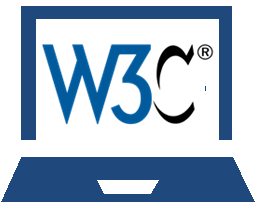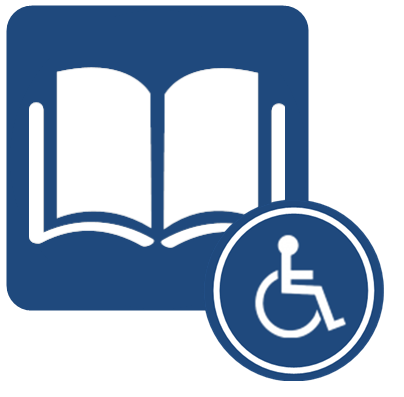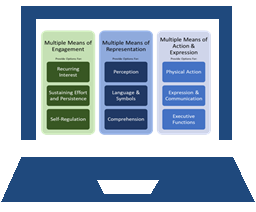Digital Accessibility: Barriers in Post-Secondary Education
Sownthy Senthilchelvan
Introduction
As technology increasingly dominates our daily lives, our interaction with digital tools becomes more integral. Despite efforts to integrate digital technologies into educational frameworks, significant barriers to accessibility persist. A 2016 study revealed that 70% of major universities lacked the necessary assistive technologies for student use, even as learning environments transitioned to online platforms (Idaho Training Clearinghouse, n.d.). The number of students who have a disability has substantially increased over the years. Between the academic years 2009-2010 and 2019-2020, the number of registered students with disabilities increased by over 132% (Ontario Newsroom, 2021). Notably, in the 2019-2020 academic year, nearly 92,000 students registered with Offices for Students with Disabilities at publicly funded colleges and universities (Ontario Newsroom, 2021). With the lack of accessibility at a post-secondary education level, fewer students with disabilities are set up for success by the educational system. 16.4% of students with disabilities completed their post-secondary education compared to the 34.6% of students who do not have a disability (Idaho Training Clearinghouse, n.d.).
This chapter discusses various topics around accessibility, including the importance of digital accessibility barriers in post-secondary education and some common challenges students face. This chapter also takes a deeper dive into some proposed solutions to combat some of the barriers and how they can be used to provide more inclusive learning environments for all students.
Learning Management Systems (LMS)
 A common challenge with digital accessibility in post-secondary education is the websites and LMS platforms universities use to teach students. According to UC Berkeley (UC Regents, 2024), digital accessibility can be described as using websites, tools, and various technologies designed and developed so that people with disabilities can use them. Websites and LMS platforms may not be fully accessible to students using screen readers or other assistive technologies. Assistive technology helps individuals with difficulty speaking, typing, writing, hearing, and seeing through software and equipment. Assistive technology is used to increase, maintain, and/or improve the functional capabilities of a person with a disability (Assistive Technology Industry Association, 2024). For example, Ontario Tech University uses Canvas (Instructure, 2024) as its main learning management system. Within the LMS, no screen reader is embedded into the software, which does not benefit students who require them to learn. This now forces students to have another screen reader application to get their content read aloud for them. The American Foundation for the Blind (AFB) stated in 2024 that screen reader prices vary from free to $1200 depending on the functionality of the screen reader. Screen readers are mainly for those who suffer from vision impairment to read text on the screen but can also be used by choice for those who travel or prefer to have text read aloud to them (AFB, 2024). When deciding which screen reader to purchase, some factors need to be considered, such as whether the screen reader application is compatible with the computer’s operating system, whether it would work with other applications you intend to use it for, or whether it would work with a braille display (AFB, 2024). These are considerations that may be extensive for students with disabilities to think about while trying to navigate post-secondary education. With various universities using different LMS platforms, not embedding a screen reader application contributes to the barriers to digital accessibility for students.
A common challenge with digital accessibility in post-secondary education is the websites and LMS platforms universities use to teach students. According to UC Berkeley (UC Regents, 2024), digital accessibility can be described as using websites, tools, and various technologies designed and developed so that people with disabilities can use them. Websites and LMS platforms may not be fully accessible to students using screen readers or other assistive technologies. Assistive technology helps individuals with difficulty speaking, typing, writing, hearing, and seeing through software and equipment. Assistive technology is used to increase, maintain, and/or improve the functional capabilities of a person with a disability (Assistive Technology Industry Association, 2024). For example, Ontario Tech University uses Canvas (Instructure, 2024) as its main learning management system. Within the LMS, no screen reader is embedded into the software, which does not benefit students who require them to learn. This now forces students to have another screen reader application to get their content read aloud for them. The American Foundation for the Blind (AFB) stated in 2024 that screen reader prices vary from free to $1200 depending on the functionality of the screen reader. Screen readers are mainly for those who suffer from vision impairment to read text on the screen but can also be used by choice for those who travel or prefer to have text read aloud to them (AFB, 2024). When deciding which screen reader to purchase, some factors need to be considered, such as whether the screen reader application is compatible with the computer’s operating system, whether it would work with other applications you intend to use it for, or whether it would work with a braille display (AFB, 2024). These are considerations that may be extensive for students with disabilities to think about while trying to navigate post-secondary education. With various universities using different LMS platforms, not embedding a screen reader application contributes to the barriers to digital accessibility for students.
Other associated challenges with LMS include poor usability, lack of access to content, and lack of integration (ExpertusONE, 2024). Recognizing these common issues associated with LMS, it becomes evident that a significant gap exists between students with disabilities and equitable access to post-secondary education. Idaho Training Clearinghouse (n.d) stated that a contributing factor to the disparity is the lack of adequate support systems for students with disabilities at post-secondary institutions. For example, without the provision of assistive learning technology, students with disabilities encounter significant obstacles in accessing distance learning programs and engaging in class discussions through LMS platforms (Idaho Training Clearinghouse, n.d).
Accessibility Guidelines
 As time progresses and technology evolves, current accessibility guidelines also possess limitations that hinder the widespread adoption and efficacy of digital accessibility solutions (Kulkarni, 2019). For instance, there seems to be insufficient comprehensive evidence on the effectiveness of accessibility standards and guidelines, as stated by Kulkarni (2019). The complexity of accessibility guidelines can hinder the design and development of accessible services (Kulkarni, 2019). Waller (2023) stated that even with accessibility guidelines, the information needed to execute a digital accessibility plan is unclear to most. The standards and guidelines for accessibility are mainly directed toward designers and developers of websites and platforms, which may not be easy for everyone to understand and use. As post-secondary education increasingly embraces digital learning platforms, many educators could find themselves working with LMS that they did not select. While accessibility guidelines and standards are typically formulated for web developers, post-secondary educators, as end-users, could lack the expertise to effectively incorporate these guidelines into their course content and delivery methods through the LMS without adequate training and resources. Recognizing the efforts of post-secondary education trying to be inclusive, it is apparent that the complexity of document and content formatting can be a significant obstacle. This issue is particularly pronounced without the necessary training to understand and implement accessibility guidelines effectively.
As time progresses and technology evolves, current accessibility guidelines also possess limitations that hinder the widespread adoption and efficacy of digital accessibility solutions (Kulkarni, 2019). For instance, there seems to be insufficient comprehensive evidence on the effectiveness of accessibility standards and guidelines, as stated by Kulkarni (2019). The complexity of accessibility guidelines can hinder the design and development of accessible services (Kulkarni, 2019). Waller (2023) stated that even with accessibility guidelines, the information needed to execute a digital accessibility plan is unclear to most. The standards and guidelines for accessibility are mainly directed toward designers and developers of websites and platforms, which may not be easy for everyone to understand and use. As post-secondary education increasingly embraces digital learning platforms, many educators could find themselves working with LMS that they did not select. While accessibility guidelines and standards are typically formulated for web developers, post-secondary educators, as end-users, could lack the expertise to effectively incorporate these guidelines into their course content and delivery methods through the LMS without adequate training and resources. Recognizing the efforts of post-secondary education trying to be inclusive, it is apparent that the complexity of document and content formatting can be a significant obstacle. This issue is particularly pronounced without the necessary training to understand and implement accessibility guidelines effectively.
Non-Accessible Documents and PDFs
 Educational materials such as PDFs, Word documents, and PowerPoint presentations may not be formatted properly for accessibility, making it difficult for screen readers to interpret. This issue creates another barrier to digital accessibility for students in post-secondary education. A limitation posed by digital accessibility is the lack of resources of staff and those working within institutions to understand the full scope of digital accessibility and functionality (Kulkarni, 2019). This is a statement I agree with myself, and the reason is that when working with Word (Microsoft, 2024d) and PowerPoint (Microsoft, 2024c), I was not expected to know nor was taught about the accessibility features of these applications until this course, where the professor took the time to show us accessibility features. According to the University of New Hampshire (UNH) (2024), PDFs are a common way of distributing documents, but it can be challenging to format them to make them accessible. This is because multiple layers must be added to the document, such as tags, which take time to formulate and apply to the document and input the content (UNH, 2024). Another digital accessibility barrier to inaccessible documents is that tables and charts are challenging to format to be fully accessible (UNH, 2024). My experience of attempting to format tables to be accessible was extremely difficult, even with the assistance of other supporting students. While post-secondary institutions emphasize content delivery, ensuring document accessibility could present significant challenges. This challenge could result in a substantial barrier for students with disabilities, who may struggle to access the same information as their peers.
Educational materials such as PDFs, Word documents, and PowerPoint presentations may not be formatted properly for accessibility, making it difficult for screen readers to interpret. This issue creates another barrier to digital accessibility for students in post-secondary education. A limitation posed by digital accessibility is the lack of resources of staff and those working within institutions to understand the full scope of digital accessibility and functionality (Kulkarni, 2019). This is a statement I agree with myself, and the reason is that when working with Word (Microsoft, 2024d) and PowerPoint (Microsoft, 2024c), I was not expected to know nor was taught about the accessibility features of these applications until this course, where the professor took the time to show us accessibility features. According to the University of New Hampshire (UNH) (2024), PDFs are a common way of distributing documents, but it can be challenging to format them to make them accessible. This is because multiple layers must be added to the document, such as tags, which take time to formulate and apply to the document and input the content (UNH, 2024). Another digital accessibility barrier to inaccessible documents is that tables and charts are challenging to format to be fully accessible (UNH, 2024). My experience of attempting to format tables to be accessible was extremely difficult, even with the assistance of other supporting students. While post-secondary institutions emphasize content delivery, ensuring document accessibility could present significant challenges. This challenge could result in a substantial barrier for students with disabilities, who may struggle to access the same information as their peers.
Lack of Closed-Captions for Multimedia Content
![]() Videos and audio recordings used in lectures or course materials frequently do not include captions or transcripts, which creates a barrier for students who are hard of hearing, preventing them from being able to engage with the content fully. Not only do those who are hard of hearing use captions, but others also use them. Pogue (2024) found that 34% of Americans have subtitles on at all times for many reasons, such as watching content in different accents and languages or for those who are hard of hearing. As an individual who suffers from partial hearing loss, I always have subtitles on so I do not miss anything in translation, and it becomes helpful when watching shows in different languages. At a post-secondary education level, instructors may include videos as a part of readings or post pre-recorded lectures without captions, which becomes inaccessible to some. Specific platforms like TikTok cannot recognize voice patterns and automatically automate text (Lerman, 2021). This becomes challenging and frustrating for those who want to engage with the video but can not due to the lack of accessibility. It is crucial to double-check which platforms are being provided to students to ensure the platform can automate speech-to-text or allow educators access to transcribe information.
Videos and audio recordings used in lectures or course materials frequently do not include captions or transcripts, which creates a barrier for students who are hard of hearing, preventing them from being able to engage with the content fully. Not only do those who are hard of hearing use captions, but others also use them. Pogue (2024) found that 34% of Americans have subtitles on at all times for many reasons, such as watching content in different accents and languages or for those who are hard of hearing. As an individual who suffers from partial hearing loss, I always have subtitles on so I do not miss anything in translation, and it becomes helpful when watching shows in different languages. At a post-secondary education level, instructors may include videos as a part of readings or post pre-recorded lectures without captions, which becomes inaccessible to some. Specific platforms like TikTok cannot recognize voice patterns and automatically automate text (Lerman, 2021). This becomes challenging and frustrating for those who want to engage with the video but can not due to the lack of accessibility. It is crucial to double-check which platforms are being provided to students to ensure the platform can automate speech-to-text or allow educators access to transcribe information.
Solutions to Address Accessibility Issues
Recognizing the barriers to digital accessibility is the first step toward addressing these challenges. Numerous solutions and resources are available to create a more inclusive learning environment for post-secondary education students. By leveraging these tools and best practices, institutions can enhance accessibility and ensure equal student access. This section will review various resources and potential proposals to combat digital accessibility.
Web Accessibility Evaluation Tools
 As educators who are trying to become more involved in the learning process of digital accessibility, there are web accessibility evaluation tools that can be used to help the user make their content accessible. An example of this would be WAVE (WebAIM, 2024), a tool that helps individuals make their digital content accessible using a program that also follows Web Content Accessibility Guidelines (WCAG) but also facilitates human evaluation of digital content. WAVE is driven by a philosophy that emphasizes addressing known user-impact issues, facilitating human assessment, and fostering education on web accessibility.
As educators who are trying to become more involved in the learning process of digital accessibility, there are web accessibility evaluation tools that can be used to help the user make their content accessible. An example of this would be WAVE (WebAIM, 2024), a tool that helps individuals make their digital content accessible using a program that also follows Web Content Accessibility Guidelines (WCAG) but also facilitates human evaluation of digital content. WAVE is driven by a philosophy that emphasizes addressing known user-impact issues, facilitating human assessment, and fostering education on web accessibility.
From a post-secondary perspective, this can be a great tool that would provide extra support for instructors and staff when trying to teach content digitally, where they are working with resources that would help check for accessibility errors and how they can be improved to be accessible. Accessibility guidelines may be overwhelming for educators to understand when it is more directed toward developers and designers. Accessibility guidelines such as WCAG are embedded into WAVE, which can help detect errors or give pointers where accessibility can be improved. Not only does WAVE function from a technical point of view, but it also helps evaluate content from a human perspective, which would help make the content more relatable and accessible for students with disabilities.
Document Accessibility Tools
 As previously discussed, educational materials, including PDFs, Word documents, and PowerPoint presentations, often lack proper accessibility formatting, therefore hindering screen reader interpretation. Software such as Adobe Acrobat Pro now offers tools for creating, editing, and verifying the accessibility of PDF documents (Adobe, 2024). Alongside software that can help make documents accessible, there are courses on LinkedIn for creating accessible PDFs and Word documents (Chelius, 2017). There are various levels of depth regarding the courses, so everyone can learn based on their comfort level.
As previously discussed, educational materials, including PDFs, Word documents, and PowerPoint presentations, often lack proper accessibility formatting, therefore hindering screen reader interpretation. Software such as Adobe Acrobat Pro now offers tools for creating, editing, and verifying the accessibility of PDF documents (Adobe, 2024). Alongside software that can help make documents accessible, there are courses on LinkedIn for creating accessible PDFs and Word documents (Chelius, 2017). There are various levels of depth regarding the courses, so everyone can learn based on their comfort level.
With Word and PowerPoint applications, Microsoft Office developed an accessibility checker, now a built-in tool in Microsoft to check and improve the accessibility of documents (Microsoft, 2024a). Microsoft created a best practices table that discusses the issue, how to find it, why you must fix it, and how to fix it, along with step-by-step instructions on navigating the features (Microsoft, 2024b). There is even a feature within Word that can test your accessibility with an immersive reader so it can read your content aloud to better understand how accessible the document is (Microsoft, n.d).
Post-secondary institutions should include Adobe Acrobat Pro and Microsoft accessibility references for educators and students to download for free, so it helps set them up for success in digital accessibility. Free online resources such as LinkedIn learning courses (LinkedIn Corporation, 2024) would be an excellent opportunity for staff to complete the modules and be well-equipped with accessibility features. Post-secondary institutions should also consider embedding software like Adobe Acrobat Pro into their LMS. Hence, it is easier for students who use screen readers to access their materials without having external applications to screen read for them. It would also be an excellent opportunity to upload these tools onto the LMS so they can be accessible to all and could be used as a reference point.
Universal Design for Learning Tools (UDL)
 According to the Center for Applied Special Technology (CAST), UDL aims to devise teaching methodologies that ensure equitable access to the classroom curriculum for all students, encompassing those with diverse learning needs, disabilities, and cultural backgrounds (CAST, 2001; Pace & Schwartz, 2008). In terms of education, UDL attempts to create a more flexible curriculum that is accessible to a wide group of students by providing various opportunities to learn (Pace & Schwartz, 2008). Using CAST guidelines for UDL helps provide a framework for designing educational environments that enable all learners to gain knowledge, skills, and enthusiasm for learning (Pace & Schwartz, 2008).
According to the Center for Applied Special Technology (CAST), UDL aims to devise teaching methodologies that ensure equitable access to the classroom curriculum for all students, encompassing those with diverse learning needs, disabilities, and cultural backgrounds (CAST, 2001; Pace & Schwartz, 2008). In terms of education, UDL attempts to create a more flexible curriculum that is accessible to a wide group of students by providing various opportunities to learn (Pace & Schwartz, 2008). Using CAST guidelines for UDL helps provide a framework for designing educational environments that enable all learners to gain knowledge, skills, and enthusiasm for learning (Pace & Schwartz, 2008).
Typically, at the post-secondary level, the content delivery is the standardized professor lecturing the class, where the professor determines the objectives, outcomes, readings, and assignments. The professor focuses on the course’s knowledge aspect, not necessarily on how the students can access the information (Pace & Schwartz, 2008). This creates a barrier to accessibility for students at the post-secondary level. This is where UDL can be used as a driving force to build the framework of accessible learning through various modes of teaching information. Digital learning is relatively new, and digital accessibility may have been taken for granted. However, with technological advancements, incorporating UDL into digital learning would help post-secondary education prioritize the students to make content accessible.
Conclusion
As technology becomes integral to our daily lives, our reliance on digital tools grows. Despite efforts to incorporate digital technologies into educational systems, barriers to digital accessibility remain. Key obstacles include LMS used by universities, which often lack compatibility with screen readers and distribute non-accessible documents and PDFs. Many educators are unfamiliar with formatting these materials to be accessible, resulting in a learning gap for students with disabilities. Additionally, the complexity of accessibility guidelines can hinder the design and development of accessible services. The lack of closed captions for multimedia content also presents challenges for students who are hard of hearing. To address these issues, solutions such as web accessibility evaluation tools, document accessibility tools, and universal design for learning principles have been proposed. Utilizing these resources and tools can help bridge the accessibility gap, ensuring all students have equitable access to post-secondary education.
References
Adobe (2024). Adobe Acrobat Pro. https://www.adobe.com/ca/acrobat/acrobat-pro.html
Assistive Technology Industry Association (2024). What is AT? https://www.atia.org/home/at-resources/what-is-at/
American Foundation for the Blind (2024). Screen readers. https://www.afb.org/blindness-and-low-vision/using-technology/assistive-technology-products/screen-readers
Chelius, C. (2021). Creating Accessible PDFs. Linkedin Learning. https://www.linkedin.com/learning/creating-accessible-pdfs-14445392
ExpertusONE (2024). Top LMS problems: Lack of reporting and integration. ExpertusONE Learning Platform. https://expertusone.com/lack-of-reporting-and-integration-are-biggest-lms-challenges
Idaho Training Clearinghouse (n.d). The Essential Guide to Digital Accessibility in Higher Education. [PDF file]. https://idahotc.com/Portals/0/Resources/640/Essential%20Guide%20to%20Digital%20Accessibility%20in%20Higher%20Education.pdf
Instructure (2024). You. The Power of Canvas by Instructure. https://www.instructure.com/canvas
Kulkarni, M. (2019). Digital accessibility: Challenges and opportunities. IIMB Management Review, 31(1), 91–98. https://doi.org/10.1016/j.iimb.2018.05.009
Lerman, R. (2021, March 15). Social media has upped its accessibility game. But deaf creators say it has a long way to go. Washington Post. https://www.washingtonpost.com/technology/2021/03/15/social-media-accessibility-captions/
LinkedIn Corporation (2024). LinkedIn Learning. https://www.linkedin.com/learning/
Microsoft (2024a). Make your content accessible to everyone with the Accessibility Checker. Microsoft Support. https://support.microsoft.com/en-us/office/make-your-content-accessible-to-everyone-with-the-accessibility-checker-38059c2d-45ef-4830-9797-618f0e96f3ab
Microsoft (2024b). Make your Word documents accessible to people with disabilities. https://support.microsoft.com/en-us/office/make-your-word-documents-accessible-to-people-with-disabilities-d9bf3683-87ac-47ea-b91a-78dcacb3c66d
Microsoft (2024c). PowerPoint. https://www.microsoft.com/en-us/microsoft-365/powerpoint
Microsoft (2024d). Word. https://www.microsoft.com/en-us/microsoft-365/word
Ontario Newsroom (2021). Ontario Expanding Employment Supports for Postsecondary Students with Disabilities. https://news.ontario.ca/en/release/1001275/ontario-expanding-employment-supports-for-postsecondary-students-with-disabilities
Pace, D. & Schwartz, D. (2008). Accessibility in Post Secondary Education: Application of UDL to College Curriculum. US-Chine Education Review, 5(12), 20-22. https://files.eric.ed.gov/fulltext/ED503884.pdf
Pogue, D. (2024). Read all about it: The popularity of turning captions on. CBS News. https://www.cbsnews.com/news/subtitles-why-most-people-turn-tv-captions-on/
UC Regents (2024). What is digital accessibility? Berkeley Digital Accessibility. https://dap.berkeley.edu/learn/what-digital-accessibility
University of New Hampshire (2024). Documents and PDFs. Diversity, Equity, Access & Inclusion. https://www.unh.edu/diversity-inclusion/accessible/accessibility-action/build-accessible-resources/documents-pdfs
Waller, C. (2023). The State of Global Digital Accessibility: Current Challenges and Opportunities. Accessibility.com. https://www.accessibility.com/blog/the-state-of-global-digital-accessibility-current-challenges-and-opportunities
WebAIM (2024). WAVE Web Accessibility Evaluation Tools. https://wave.webaim.org/
